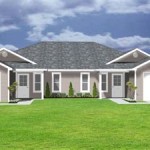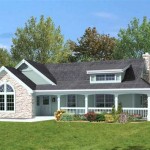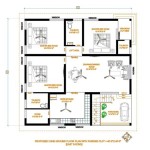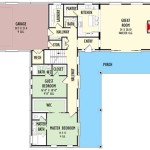One-Story House Plans with Butler's Pantry: Enhancing Functionality and Flow
The demand for single-story home designs continues to rise, driven by factors such as accessibility, ease of maintenance, and the growing preference for aging-in-place. Within this architectural trend, the inclusion of a butler's pantry has emerged as a popular feature, adding a layer of convenience and elegance to everyday living. This article will explore the benefits and considerations of incorporating a butler's pantry in one-story house plans, discussing its functionalities, design aspects, and impact on overall home value.
A butler's pantry, historically a space reserved for the storage and polishing of silverware, has evolved into a versatile extension of the kitchen. In contemporary home design, it serves as a transitional zone, bridging the kitchen and dining area, and providing additional storage, preparation, and serving space. When integrated into a one-story house plan, the butler's pantry can significantly enhance the functionality of the kitchen, particularly in open-concept layouts where minimizing clutter and maximizing efficiency are paramount.
Efficient Space Utilization in Single-Story Homes
One of the primary advantages of incorporating a butler's pantry within a single-story home plan is its ability to optimize space utilization. Unlike multi-story homes where storage can be distributed across different levels, single-story dwellings require careful planning to maximize every square foot. A butler's pantry provides a dedicated area for storing infrequently used appliances, bulk food items, and serving ware, thereby freeing up valuable cabinet space in the main kitchen area. This is particularly beneficial in smaller one-story homes where kitchen space may be limited.
Furthermore, a well-designed butler's pantry can function as a staging area for meal preparation and service. It can include features such as a secondary sink, countertop space for assembling dishes, and warming drawers to maintain food temperature. This allows for a smoother transition from cooking to serving, especially during dinner parties and other gatherings. By segregating these activities from the main kitchen area, the butler's pantry helps to maintain a cleaner and more organized environment for both the cook and the guests.
Moreover, the strategic placement of a butler's pantry can improve the overall flow of the home. By acting as a buffer between the kitchen and dining room, it can minimize noise and visual clutter, creating a more relaxed and inviting dining experience. This is particularly important in open-concept layouts where the kitchen, dining, and living areas are seamlessly integrated. A butler's pantry can help to define these spaces while maintaining a sense of openness and connectivity.
Key Design Considerations for Butler's Pantries
The design of a butler's pantry should be carefully considered to ensure it meets the specific needs and preferences of the homeowner. Several key factors influence the functionality and aesthetic appeal of this space, including layout, storage solutions, lighting, and materials. When planning a butler's pantry in a one-story house plan, it's essential to work with an architect or designer who understands the principles of space planning and kitchen design.
The layout of the butler's pantry should be optimized for efficiency and ease of use. A common configuration is a galley-style layout, with countertops and storage on both sides of a central aisle. This allows for ample workspace and storage while maintaining a compact footprint. Alternatively, a walk-in pantry design can provide even more storage space but requires a larger area. It is crucial to consider the flow of traffic between the kitchen, dining room, and butler's pantry to ensure a seamless and intuitive experience.
Storage solutions within the butler's pantry should be tailored to the specific items being stored. Adjustable shelves, pull-out drawers, and specialized organizers can help to maximize space and improve accessibility. Open shelving can be used to display decorative items or frequently used items, while closed cabinets can conceal less aesthetically pleasing items. Wine racks, spice storage, and appliance garages are other specialized storage solutions that can be incorporated into the design.
Lighting is another critical aspect of butler's pantry design. Adequate lighting is essential for performing tasks such as food preparation and serving. A combination of ambient, task, and accent lighting can create a well-lit and inviting space. Under-cabinet lighting is particularly useful for illuminating countertops, while pendant lights can add a touch of style and sophistication. Natural light should also be considered, if possible, as it can enhance the sense of spaciousness and airiness.
The materials used in the butler's pantry should complement the overall aesthetic of the home. Common choices include durable and easy-to-clean materials such as quartz countertops, tile backsplashes, and painted cabinetry. The color palette should be consistent with the kitchen and dining areas to create a cohesive and harmonious look. Adding decorative elements such as decorative hardware, wallpaper, or artwork can personalize the space and reflect the homeowner's individual style.
Enhancing Home Value and Lifestyle
Incorporating a butler's pantry into a one-story house plan can not only enhance the functionality of the home but also increase its value and appeal to potential buyers. A well-designed butler's pantry is often perceived as a luxury feature, signaling attention to detail and a commitment to quality. This can be a significant selling point in a competitive real estate market.
Beyond its potential to increase home value, a butler's pantry can also improve the homeowner's lifestyle. By providing a dedicated space for food preparation, storage, and serving, it can streamline daily routines and make entertaining easier and more enjoyable. The added storage capacity can reduce clutter and create a more organized and efficient living environment. This can be particularly beneficial for families with young children or those who frequently host gatherings.
Furthermore, a butler's pantry can serve as a multi-functional space that adapts to the changing needs of the homeowner. It can be used as a home office, a crafting area, or a bar area, depending on the individual's preferences. This versatility makes it a valuable asset that can enhance the long-term enjoyment and usability of the home. By thoughtfully integrating a butler's pantry into a one-story house plan, homeowners can create a space that is both practical and aesthetically pleasing, adding value to their property and enriching their daily lives. Thoughtful planning and execution are crucial to maximize the potential benefits. Considering factors like accessibility, storage needs, workflow, and budget constraints ensures a seamless integration of the butler's pantry into the overall home design.
The inclusion of electrical outlets within the butler's pantry is paramount. Multiple outlets should be strategically placed along countertops and walls to accommodate small appliances such as blenders, coffee makers, or warming trays. Dedicated circuits may be necessary for larger appliances to prevent overloading. Furthermore, proper ventilation should be considered to dissipate heat and odors generated by appliances.
Plumbing considerations are equally important when planning a butler's pantry. If a sink is desired, plumbing lines for both hot and cold water must be installed, along with a drainage system. The location of the plumbing should be carefully coordinated with the layout of the cabinetry and countertops to ensure a seamless and functional design. A small dishwasher or ice maker may also necessitate additional plumbing connections.
Accessibility is a key factor, particularly in single-story homes where aging-in-place is a common consideration. The butler's pantry should be designed with wider doorways and aisles to accommodate wheelchairs or walkers. Countertops should be at varying heights to accommodate different users, and pull-down shelves or drawers can improve accessibility to items stored higher up. Attention to these details ensures that the butler's pantry is both functional and accessible for all members of the household.

Image Result For House Plans With Butlers Pantry New Southern

House Styles What S Hot And Not Houseplans Blog Com

4 Bedroom House Plans With Butlers Pantry Inspirational 138 Best Planos De Casas Casa Perfecta

New Home Designs Single Double Y House Floor Plans Ridge

Harrison Place House Plans Cool Designs Dream

House Plan 28108ll Quality Plans From Ahmann Design

4 Bed Coastal Contemporary House Plan With Butler S Pantry And Covered Lanai 33239zr Architectural Designs Plans

Transitional Country Farmhouse Plan Split Bedroom 2742 Sq Ft

3 Bed Modern Farmhouse Plan With Walk Through Pantry And Bonus Room 510094wdy Architectural Designs House Plans

House Plan 5 Bedrooms 3 Bathrooms Garage 3926 V1 Drummond Plans








